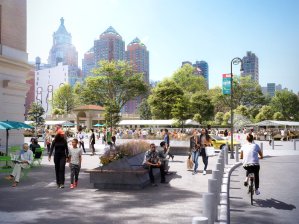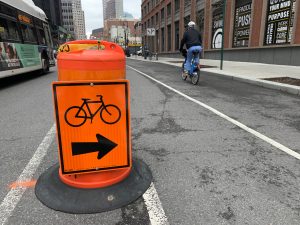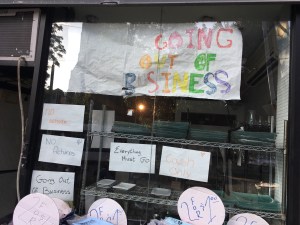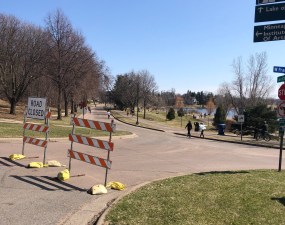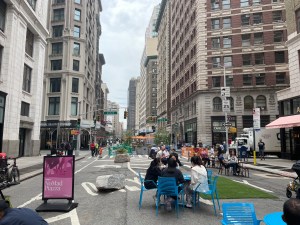Neighborhoods, BIDs to Mayor: We Don’t Need Your Cops — Let Us Open Streets Ourselves!
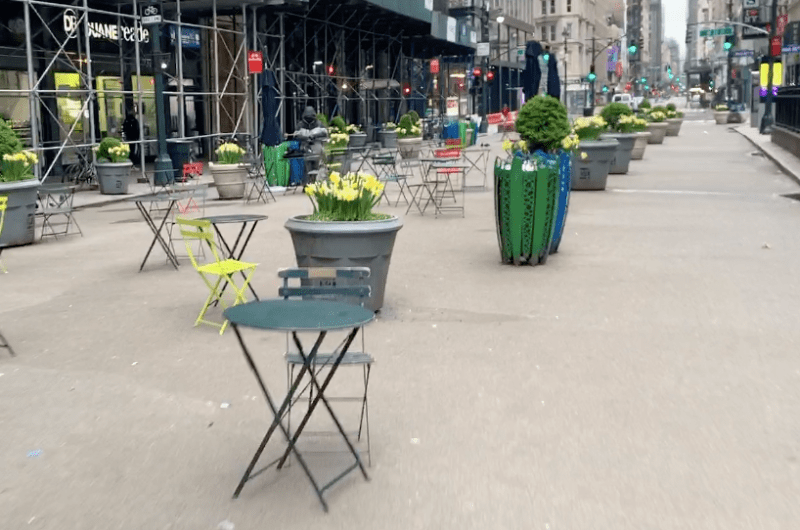
It’s “open” season, but the mayor’s mind is closed.
Neighborhood groups all over the city — and the leaders of key Manhattan business improvement districts — are begging the de Blasio administration to close many miles of roadways to cars so that people can recreate or simply get around in a socially responsible manner during the COVID-19 crisis. But Mayor de Blasio again said no on Friday.
But in spite of (or perhaps because of) the mayor, focus has started shifting to Broadway in Manhattan.
Streetsblog has learned that officials with the business improvement districts from SoHo up to Times Square have offered the Department of Transportation their security and sanitation services to encourage the city to make Broadway a linear park for people, not cars. Manhattan Borough President Gale Brewer is said to be spearheading the effort. (And late on Friday released a letter [PDF] openly joining the effort.)
There’s a sticking point: the mayor and his belief that only the NYPD can keep people safe in open spaces.

The 1.3 miles of Broadway from Times Square to Union Square is a perfect “open streets” test case, now, but also going forward: The roadway has already been redesigned to narrow the lanes for car travel, the one-day southbound roadway is redundant as it hypotenuses between Seventh and Park avenues, and very few vehicles use it as a thru-street because they are diverted by existing plazas at Herald, Worth, Flatiron and Union squares.
“We could do Broadway pretty quickly with cones and barricades — and minimal NYPD support,” said an official with a different Midtown-area BID. “And it’s not just for Broadway, but to show the city how easily this could be rolled out and scalable in other neighborhoods. The real roadblock is the mayor.”
Indeed, on WNYC’s “Ask the Mayor” segment on Friday, host Brian Lehrer asked de Blasio about a just-announced plan by Oakland Mayor Libby Schaff to create 74 miles of new public space by banning cars on 10 percent of her city’s roadways. By comparison, de Blasio had created 1.5 miles — .o2 percent of New York streets — in a pilot program that ended after just 11 days because of the mayor’s insistence on deploying at least two cops per intersection.
“I’m not familiar with the Oakland model,” the mayor said, before discussing his failed experiment:
The fear that I had and the NYPD had … was that we would create new focal points for gathering and that we couldn’t properly enforce it. … It’s been a challenge where there’s been a lot of enforcement to do and fewer people to do it with and a huge city. So, the original concept, we tried it. … We realized it was taking up a lot of enforcement. So, we said this just can’t work at this moment, certainly with NYPD and other agencies depleted. But I do get the point like wouldn’t it be great if just there was lots of space for everyone to walk around? It would be great if it did not cause gatherings and therefore create new problems. And it would be great if there was not the problem of all the stuff that still has to keep happening. Obviously emergency vehicles are being called on constantly. … We have to be careful that we cannot create a situation where we clog all of that up. So, I’m going to look at the model further, but to date the answer is, it is not enforceable the way we need it to be. And it disrupts other things we need desperately in this moment.
Both BID officials pushed back on the mayor’s continued lack of interest in creating more public space now and, presumably, when everything gets back to the very abnormal “normal.”
“We need to think about the kind of city we will want to live in when people do eventually go back to work,” one said. “For starters, they’re not going to go right back to the subway or the bus, so many will continue biking or walking, which is easy to do now, but won’t be when there are thousands of people walking around.
“The name of the game right now is reducing crowding,” the BID official added, “but going forward, it’s going to be walking, biking and micro-mobility that all need to be increased. But the mayor wants to go in the other direction.”
The effort to fix our city now so that it is more resilient in the future goes far beyond a handful of Manhattan BIDs. Community groups and Council Members have also reached out to City Hall with laundry lists of streets that should be made car-free for the duration of the lockdown. (Transportation Alternatives has its open-space petition here.)
In Chelsea and Hells Kitchen, the venerable community group CHEKPEDS asked for 16 residential streets between 14th and 56th streets to be made car-free — an area comprising more than 11 miles in just two neighborhoods (a proposal that comprises more than 10 times the space of the mayor’s entire initial pilot program).
“Implementation need not be complex or require NYPD assistance,” the group’s co-founder Christine Berthet said. “Simple cones and a sign at each street entrance, installed by the block association, should be sufficient, which will also allow ambulances, sanitation and local residents to pass as needed.”
Berthet put her finger on the larger issue: the mayor’s fealty to the NYPD.
“It’s hopeless because de Blasio is only listening to police department,” she said. “Meanwhile, there are cars speeding like crazy. So why is there no quarantine of drivers — instead we get quarantine zones for pedestrians! It was ridiculous. The world has turned upside down. Bill de Blasio believes that people in the streets is bad and cars in the street is good — and having the NYPD dictate this will result in less public car-free space, rather than more.”
In Brooklyn, Council Member Brad Lander called for 4.2 miles of roadways in his district to be opened up for people, including the 1.7-mile stretch of Prospect Avenue between Sixth Avenue and Ocean Parkway.
In the West Village, community board members have been calling for University Place between 14th Street and Washington Square Park, parts of Ninth Avenue and existing summer streets routes to be opened up for people. One board member told Streetsblog that the immediate concern was to “provide enough pedestrian space so that people can be far enough apart,” but that residents of the neighborhood also realize that the future will belong to sustainable, clean ways of getting around.
“We need to remake streets to attract people, which will improve commerce, provide more greenery etc.” said the board member. “That’s why one board member suggested pedestrianizing Chinatown. Many of us are very aware that open streets attract people and is good for commerce. Post Covid, this will be a high priority.”
Council Member Ydanis Rodriguez has been demanding that at least one lane of Broadway — on its entire 16-mile run from The Bronx border to the Staten Island Ferry terminal at Battery Plaza — be seized from car drivers and turned into open space.
He told Streetsblog he supports the BID officials’ efforts.
“We need to go in a more ambitious direction that doesn’t require police officers,” said the Upper Manhattan lawmaker. “When I saw the mayor’s closing of so few streets with so many police officers, I felt like he just put it in a position to fail rather than giving it a chance to succeed.”
For now, Council Speaker Corey Johnson said he will push the mayor.
“New York City needs to open streets to pedestrians for public health, public safety, and for our collective sanity,” he told Streetsblog in a statement. “Cities around the country and around the world are demonstrating that this is an effective tool to promote social distancing during the coronavirus pandemic. New York City should be leading the way on this issue.”
Indeed, other cities are using the crisis to plan for a brighter future rather than hunkering down and hoping they can just get back to “normal.” Across the bay from Oakland’s massive public space proposal, San Francisco’s transit director Jeffrey Tumlin is putting into place ideas that de Blasio refuses to even entertain.
“We’re always starting to think how we take advantage … to be a better city,” he said in a recent interview (below). “We are developing plans … to take the essential transit network and ensure that that essential transit network is never stuck in traffic again [and] rapidly advance a protected bike lane network to reduce greenhouse gas emissions.”
Something to look forward to: @sfmta_muni and Director @jeffreytumlin are already planning a rapid transformation of SF's streets to prioritize transit and cycling once shelter-in-place is over. pic.twitter.com/Gth2jksMMA
— Kyle Grochmal (@KCGrock) April 8, 2020
The Department of Transportation declined to comment for this story about its discussions with the BIDs and community groups.
This story created fodder for Streetsblog’s in-house satirical band, The Speeders, to offer its own version of the classic hit, “On Broadway” (George Benson version, of course). So sing along with our Soundcloud link (below) and the lyrics beneath it. Or watch our music video:
Bill says we can’t make public space on Broadway (on Broadway)
Bill says cars need more than their fair share (on Broadway)
But when you’re walking down that street
And you see so much space for feet
The mayor’s wrong — it’s clear it’s just not fair (on Broadway)
People know cars should be banned on Broadway (on Broadway)
But looking at them just gives me the blues (on Broadway)
We can beg God with our prayers
But nothing works with this here mayor
And this here mayor just repeats, “I refuse” (on Broadway)
Bill thinks Streetsblog is just so wrong on Broadway (on Broadway)
“Cars are so important here,” he just says (on Broadway)
But no, he’s wrong, we know he is
‘Cause open space is good for kids
And not just kids, but everyone on Broadway (on Broadway)
We won’t quit til there’s no cars! (On broadway)
More room for bikes and outdoor bars! (On broadway)
And we can look up at the stars! (On Broadway)
And if you want that on Soundcloud, be our guest:
And here’s Gale Brewer’s letter:
GB Letter Re Temporary Manhattan Pedestrian Improvements by Gersh Kuntzman on Scribd
